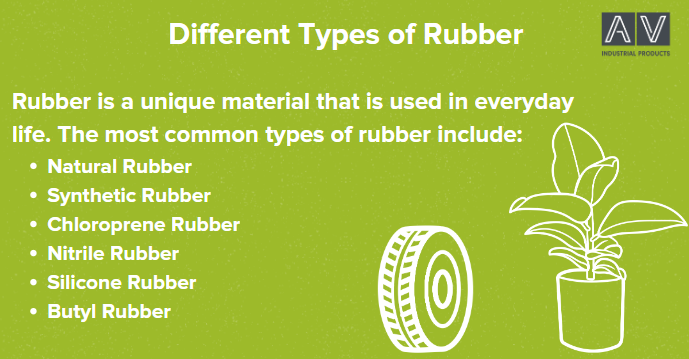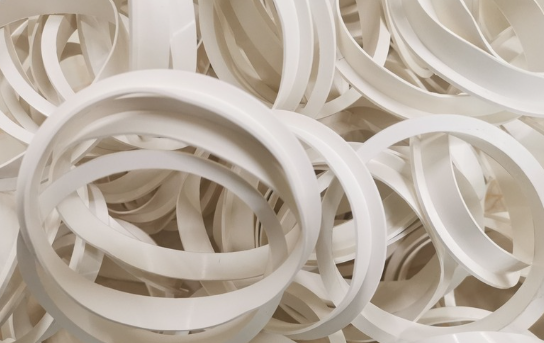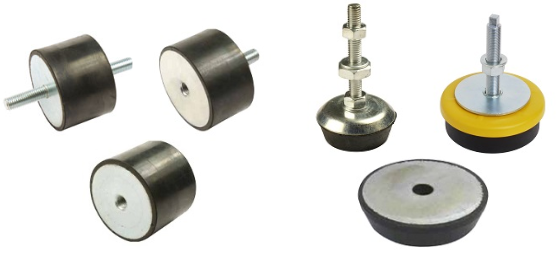If you look around, you’ll notice that different types of rubber are everywhere. Natural rubber is an essential material used in the creation of tens of thousands of everyday products. These span sectors and range from transportation to medicine to footwear. Despite becoming a staple material in our modern society, it generally goes unnoticed in our lives.
With that said, it is such an essential product that it is worth exploring in more detail. In fact, it is so indispensable to our lives that many governments have designated it a critical raw material. This is because rubber offers solutions for almost every industry. In this complete guide, you’ll discover the different types of rubber, their uses and how AV Industrial utilises rubber in our anti-vibration mountings.
What is Rubber?
Rubber is an extremely strong and durable material which can withstand stretching without breaking. It is resistant to corrosion and works as an electrical insulator. This makes it an ideal material for the production of so many products. For these reasons and more, there is no simple alternative material to replace rubber.
Key characteristics:
- Resilience
- Vibration dampening
- Tear resistance
- Tensile strength
- Abrasion resistance
- Friction
- Water repellent

What Types of Rubber are there?
So, what type of material is rubber? There are many different types of rubber but they are categorised into two types: natural rubber and synthetic rubber. Rubber as a natural material is harvested from the Hevea Brasiliensis tree. Alternatively, it is formed synthetically through chemical manufacturing processes.
Which type of rubber is best depends on the intended use, as each has different characteristics. Rubber examples used in everyday applications include natural rubber, neoprene and nitrile. From vehicle tyres to footwear, different types of rubber are made and used depending on the properties of each type.
Natural rubber:
Natural Rubber is a strong, flexible and resilient material. It is naturally formed using a milky sap (latex) collected through tapping the Hevea Brasiliensis tree. The sap becomes rubber with the addition of formic acid and drying processes. Then the addition of chemicals improves its ability to withstand extreme temperatures without becoming sticky or brittle. Finally, vulcanisation is a heat-treatment phase which makes rubber extremely strong and durable.
Natural rubbers are extensively used for both domestic and industrial purposes, including anti-vibration mounts and engineering components. Other typical uses include adhesives, flooring, gloves, insulation, and tyres. In fact, 70% of natural rubber production goes into tyre production (ISRG, 2019).
Natural (NR) common uses:
- Anti-vibration mounts
- Seals in fridges and automation
- Tyres
- Rubber bands
- Gloves

Synthetic rubber:
The first synthetic rubber was created 1909. But production of this type of rubber expanded greatly when industrial demand for natural rubber surpassed supply by the end of World War 1. This demand led to the need for synthetic rubber manufactured by chemical means rather than natural tapping.
Over the years people have developed many new synthetic rubber compounds to simulate the properties of rubber. However, to date natural rubber still retains the top position in terms of performance and resilience. With that said, synthetic rubbers are superior to natural rubbers in two key ways: thermal stability and resistance to oils.
Syntetic (SR) common uses:
- Tyres
- Door and window seals
- Footwear
- Adhesives
Chloroprene rubber:
Chloroprene rubber - otherwise known by its trade name Neoprene - is a durable rubber that closely imitates natural rubber. It also has the additional benefit of being resistant to fuels and oils and it has a high temperature resistance (typically up to 110°C).
Chloroprene(CR) common uses:
- Gaskets
- Cable jackets
- O-rings and seals
- Wetsuits
- Anti-vibration mounts

Nitrile rubber:
Nitrile rubber - otherwise known as NBR rubber or nitrile butadiene rubber - has excellent oil resistance and chemical properties. Again, it also has a slightly improved temperature resistance compared to natural rubber.
Nitrile (NBR) common uses:
- Hoses
- O-rings
- Gaskets
- Oil seals
- V belts
- Hydraulic seals
Silicone rubber:
Silicone rubber is a synthetic rubber commonly known for its biocompatible properties. This means that it can be used in the food industry and medical devices as it is compatible with living tissue without being toxic.
It also offers extremely high temperature resistance (in excess of 200°C). In contrast, it has a lower tensile strength compared to natural rubber. Plus, along with other synthetic rubbers, it is generally higher in price.
Silicon common uses:
- Medical devices
- Food storage and kitchenware
- Baby products
- Apparel such as sportswear and footwear
- Electronics (cables, connectors and seals)
- Sealants and adhesives
Butyl rubber:
Butyl rubber has excellent impermeability to gases and resistance to heat, weathering, and chemicals. It is commonly used in the manufacture of tyre inner tubes as it is able to maintain proper pressure over time. In addition, it is extremely high damping characteristics which can be useful for rubber buffers, bump stops and certain type of anti vibration mountings
Butyl common uses:
- Shock absorption and AV Mounts
- Inner tubes
- Sports equipment
- Wire and cable insulation
- Steam hoses
Did you know?
Natural rubber has played an important role in people’s lives for thousands of years. However, it was not until 1839 and the discovery of vulcanisation that rubber had its first practical application in the industrial world. Subsequently, with modern technology, synthetic rubbers were created to fill new levels of demand.
We hope that this has answered your question ‘what type of material is rubber?’ through exploring different rubber examples and their important uses. Natural rubber is still the material of choice for many products across industries. But as it comes from a small number of plantations, other alternatives are necessary to keep up with demand for this vital resource.

Why Rubber is used in our Products?
The majority of our anti-vibration mounts are produced using natural rubber. This is because it has the highest level of resilience, hence the best vibration reduction properties.
Though synthetic rubbers clearly play an important role in high temperature environments. Explore our range of rubber anti-vibration mountings for the best solution to reduce vibration in your industrial machinery and vehicles.
AV Industrial Products specialise in the manufacture of engineering rubber components and anti-vibration mounts. We offer one of the most extensive ranges of standard industrial rubber products to the industrial sector.
Our team has extensive knowledge of the unique characteristics of different types of rubber and their best uses. Take a look at our extensive range of products or to find out more information, get in touch with one of our friendly team.




